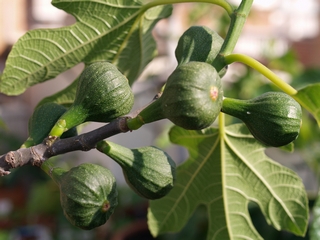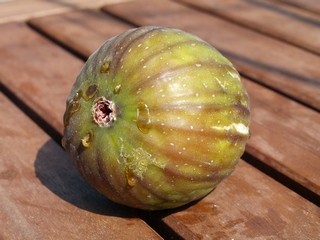
Figues-fleurs de la Brown Turkey en croissance.

Figues flors de la Brown Turkey a punt de menjar.

Figues-fleurs de la Brown Turkey prêtes à manjer.

Typologie de la feuille moins fréquente.
Pas tous les années il y a la même propotion
entre les différentes typologies. .

Brown Turkey d'été, seconde récolte.

Brown Turkey d'été, seconde récolte.

Typologie de la feuille la plus normale.
Autofèrtil (partenocàrpica)
Bífera (Figues flors i figues d'estiu)
Figues d'estiu a principis d'Agost.
Il est considéré comme étant un des figuiers les plus rustiques avec une grande résistance au froid. D’après les témoignages, ce figuier aurait survécu à des froids inférieurs à 18º C, en repoussant à nouveau de la souche, sans dommages. Une expérience suédoise très intéressante sur sa résistance au froid : Fig growing in Sweden.
Brown Turkey s'adapte aussi aux climats chauds, mais dans ce contexte il est très sensible aux maladies fongiques (rouille).
Caractéristique de l’arbre :
Arbre de taille moyenne qui s'adapte très bien à la culture en pot.
Description des figues :
Figue-fleur de taille moyenne d'environ 50 à 60 g. Qualité légèrement inférieure à la figue d'été.
Figue d'été plus petite (moins allongée), sans cou. Peau marron sur fond verdâtre.
D’un point de vue gustatif, ce n'est pas une variété remarquable.
On peut néanmoins obtenir des figues de bonne qualité avec un terreau adéquat. On devra être vigilant à bien contrôler l’arrosage et la fertilisation. Il faudra en outre impérativement situer l'arbre en plein soleil.
Hors de la culture en pot, il est difficile de réunir les conditions optimales pour obtenir des fruits acceptables. En zone où il est possible obtenir des figues d'autres variétés, sa culture n’a de sens que pour un collectionneur.
Page traduite avec la collaboration de Nadia Habib.
By Ira Condit:
The Brown Turkey that was described by Miller to be “so well known as to need nodescription” is undoubtedly a European variety, introduced into England and given a local name without reference to origin.
The synonyms, Brown Naples, Long Naples, and Italian, indicate that it came from Italy, but it has not yet been identified with any variety from that country. For more than two centuries, however, this fig has stood at the head of the list of English varieties for general cultivation, both outdoors and under glass.
Coleman reported in 1880: “For forcing we have nothing to surpass, if we have anything to equal it, as it is early, handsome, very prolific, not liable to drop, and of first-rate quality.” An anonymous writer in 1852 (see “Literature Cited”) described a tree at Worthing, trained in the form of a wheel, its branches forming twelve spokes, with the over-all height fourteen feet, and the circumference thirty feet.
In 1883, J.Clarke told of a single tree of Brown Turkey covering a wall space of twenty yards “literally crowded with magnificent and well-formed fruit.” W. I. (1893) referred to fine trees growing on the chalk cliffs of England, where the sea spray dashed over them. More recently, E. A. Bunyard wrote: “This is the variety most commonly grown; more are planted, I imagine, than of all the other varieties put together, owing to its hardiness and productivity.
According to Eisen, the Brown Turkey was brought to California from Boston by W. B. West in 1853, and from England by John Rock in 1883. It has doubtless been introduced many other times by various nurseries.
Early reports of the California
Agricultural Experiment Station include Brown Turkey among the varieties being tested at the substations. Apparently, it failed to compete successfully with other varieties, and until recently no trees were to be found, even in collections. Introductions have been made from England under P.I. Nos. 81,676, 93,275, and 95,598.
At Riverside, however, trees from these importations, as well as those obtained from the southern United States, are so badly affected by the mosaic caused by Ficivir caricae Condit and Horne, that normal fruit has seldom been produced.
(See plate 13, showing effect of mosaic on leaves.) On the other hand, trees growing in the southern and eastern states are not at all or very little affected by mosaic. They are of a dwarf habit of growth, and hardy, commonly bearing two crops.
The Brown Turkey ranks with Celeste (Malta) as the most popular dooryard fig from Texas east to Florida and north to Maryland. The Everbearing fig of Texas, described by Close (1935), is very similar to, if not identical with, Brown Turkey, although treated as a distinct variety by various nurseries. Harrison, briefly described by Close (1933), and Delta, or New Delta, described by two anonymous writers in 1943 and 1944 (see “Literature Cited”), are also very similar to Brown Turkey.
Descriptions of fruit by Eisen and some other authors are not clear, as they are probably confused with similar varieties. Confusion also exists in some descriptions, as indicated by the two synonyms, Large Blue and Small Blue, with reference to size of fruit.